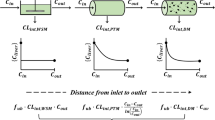Abstract
Recent publications by Benet and coworkers, Korzekwa and Nagar, and Rowland et al. signal disagreement regarding the use of Kirchhoff’s laws in combining pharmacokinetic parameters, especially clearances and rate constants. Here, it is pointed out that Kirchhoff’s laws as applied to pharmacokinetics simply assert that concentrations are well defined and that molar or mass balances hold. The real issue is how to combine parameters for clearance processes in sequence, which may be reversible, irreversible, or even active in either or both directions. It is also demonstrated that Kirchhoff’s laws cannot be used to resolve contradictory results observed in liver transport and clearance. Finally, a simple argument is provided relating nonlinear clearance to apparently anomalous bioavailability observations.
Graphical Abstract




Similar content being viewed by others
References
Riggs DS. The mathematical approach to physiological problems. Cambridge, MA: M.I.T. Press; 1963.
Levenspiel O. Chemical reaction engineering. 2nd ed. New York: Wiley; 1972.
Pachter JA, Dill KA, Sodhi JK, Benet LZ. Review of the application of Kirchhoff’s laws of series and parallel flows to pharmacology: defining organ clearance. Pharmacol Ther. 2022;239: 108278.
Benet LZ, Sodhi JK. The uses and advantages of Kirchhoff's laws vs. differential equations in pharmacology, pharmacokinetics, and (even) chemistry. AAPS J. 2023;25:38.
Korzekwa K, Nagar S. Process and system clearances in pharmacokinetic models: our basic clearance concepts are correct. Drug Metab Disp. 2023;51:532–42.
Rowland M, Weiss M, Pang KS. Kirchhoff’s laws and hepatic clearance, well-stirred model: is there are common ground? Drug Metab Disp. 2023;51:1451–4.
Sears FW, Zemansky MW. University physics. Reading, MA: Addison-Wesley; 1970.
Bose AG, Stevens KN. Introductory network theory. New York: Harper & Row; 1965.
Siebert WM. Circuits, signals, and systems. Cambridge, MA: MIT Press; 1986.
Siegel RA. Pharmacokinetic transfer functions and generalized clearances. J Pharmacokinet Biopharm. 1986;14:511–21.
Lassen NA, Perl W. Tracer kinetic methods in medical physiology. New York: Raven Press; 1979.
Cleland WW. Partition analysis and the concept of net rate constants as tools in enzyme kinetics. Biochemistry. 1975;14:3220–4.
Benet LZ, Liu S, Wolfe AR. The universally unrecognized assumption in predicting drug clearance and organ extraction ratio. Clin Pharmacol Ther. 2017;103:521–5.
Jusko WJ, Li X. Assessment of the Kochak-Benet equation for hepatic clearance for the parallel-tube model: relevance of classic clearnace concepts in PK and PBPK. AAPS J. 2022;24:5.
Kochak GM. Critical analysis of hepatic clearance based on an advection mass transfer model and mass balance. J Pharm Sci. 2020;109:2059–69.
Pang KS, Han YR, Noh K, Lee PI, Rowland M. Hepatic clearance concepts and misconceptions: why the well-stirred model is still used even though it is not physiologic reality? Biochem Pharmacol. 2019;109:2059–69.
Pang KS, Rowland M. Hepatic clearance of drugs. I. Theoretical considerations of a “well-stirred” model and a “parallel tube” model. Influence of hepatic blood flow, plasma and blood cell binding, and the hepatocellular enzymatic activity on hepatic drug clearance. J Pharmacokinet Biopharm. 1977;5:625–53.
Pang KS, Rowland M. Hepatic clearance of drugs. II. Experimental evidence for acceptance of the “well-stirred” model over the “parallel tube” model using lidocaine in the perfused rat liver in situ preparation. J Pharmacokinet Biopharm. 1977;5:655–80.
Roberts MS, Rowland M. A dispersion model of hepatic elimination: 1. Formulation of the model and bolus considerations. J Pharmacokinet Biopharm. 1986;14:227–60.
Sodhi JK, Wang H-J, Benet LZ. Are there any experimental perfusion data that preferentially support the dispersion and parallel-tube models of the well-stirred model of organ elimination? Drug Metab Disp. 2020;48:537–43.
Wilkinson GR, Shand DG. A physiological approach to hepatic drug clearance. Clin Pharmacol Ther. 1975;18:377–90.
Gibaldi M, Perrier D. Pharmacokinetics. Second ed. Swarbrick J, editor. New York: Marcel Dekker, Inc.; 1982.
Yamaoka K, Nakagawa T, Uno T. Statistical moments in pharmacokinetics. J Pharmacokinet Biopharm. 1979;6:547–58.
Mudie DM, Murray K, Hoad CL, Pritchard SE, Garnett MC, Amidon GL, et al. Quantification of gastrointestinal liquid volumes and distribution following a 240 mL dose of water in the fasted state. Mol Pharmaceutics. 2014;11:3039–47.
Rowland M, Tozer TN. Clinical pharmacokinetics and pharmacodynamics. 4th ed. Philadelphia: Kluwer/Lippincott Williams; 2011.
Grahnén A, von Bahr C, Lindström B, Rosén A. Bioavailability and pharmacokinetics of cimetidine. Eur J Clin Pharmacol. 1979;16:335–40.
Weiner IM, Roth L. Renal excretion of cimetidine. J Pharmacol Exp Ther. 1981;216:516–20.
Milhorn HTJ. The application of control theory to physiological systems. Philadephia: W.R. Saunders Company; 1966.
Funding
This work was supported by the College of Pharmacy, University of Minnesota.
Author information
Authors and Affiliations
Contributions
This work was conceived, written, and edited by Ronald A. Siegel.
Corresponding author
Ethics declarations
Conflict of Interest
The author declares no competing interests.
Additional information
Publisher's Note
Springer Nature remains neutral with regard to jurisdictional claims in published maps and institutional affiliations.
Rights and permissions
Springer Nature or its licensor (e.g. a society or other partner) holds exclusive rights to this article under a publishing agreement with the author(s) or other rightsholder(s); author self-archiving of the accepted manuscript version of this article is solely governed by the terms of such publishing agreement and applicable law.
About this article
Cite this article
Siegel, R.A. Notes on the Use of Kirchhoff’s Laws in Pharmacokinetics. AAPS J 26, 8 (2024). https://doi.org/10.1208/s12248-023-00875-6
Received:
Accepted:
Published:
DOI: https://doi.org/10.1208/s12248-023-00875-6




